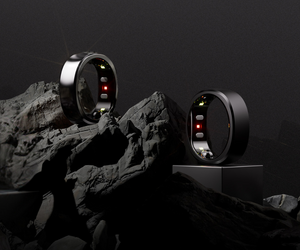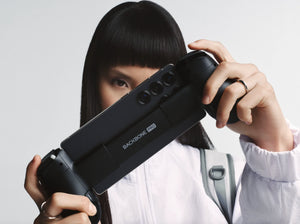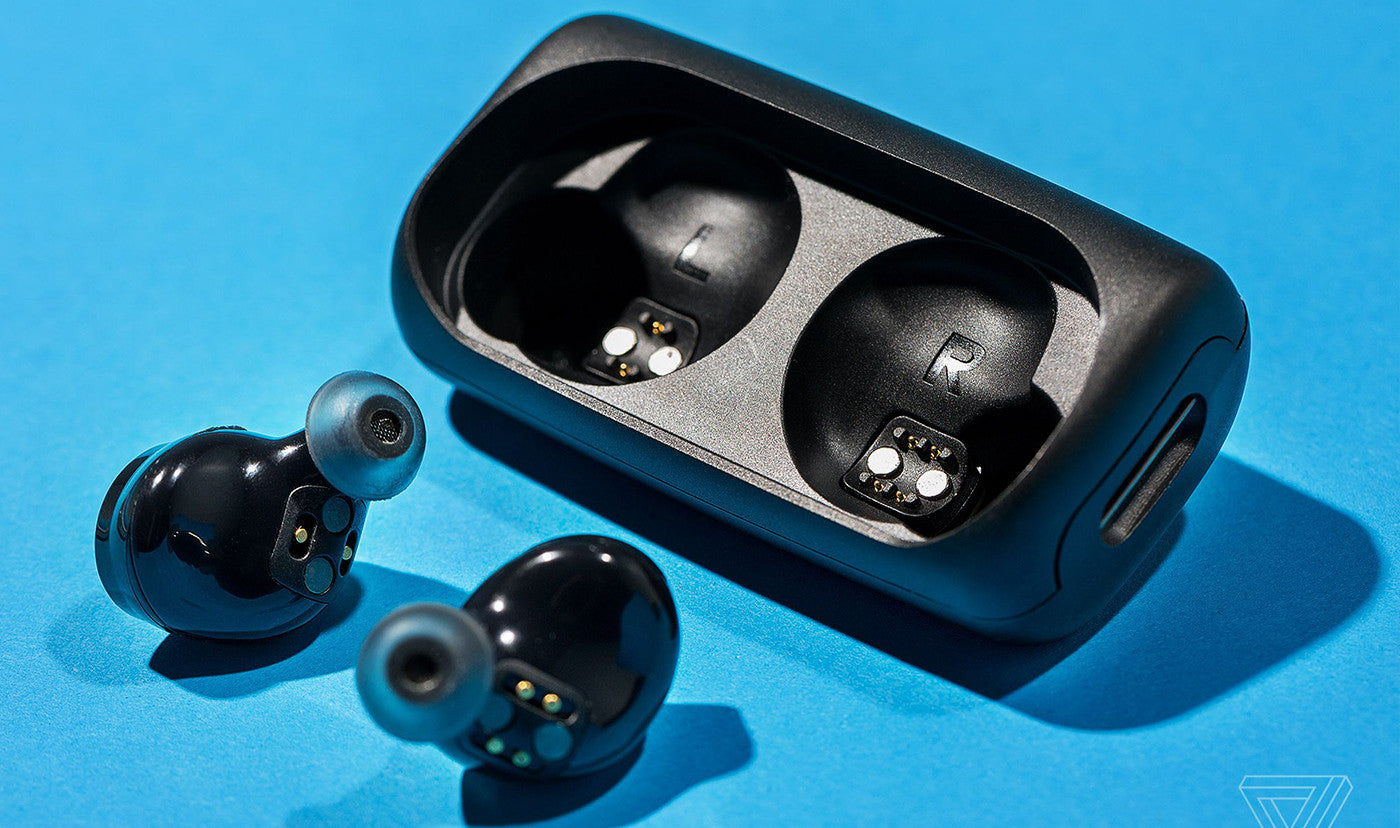/cdn0.vox-cdn.com/uploads/chorus_asset/file/7516935/akrales_161121_1292_A_0283.0.jpeg)
From the first day of Bragi’s Kickstarter, the Dash was all about fitting dozens of ideas into one product. It seemed almost too good to be true, and over the next two years that suspicion bore out — though the product was capable of wowing usin a few product demos along the way, the overall experience of the production version was a mess. Bragi tried to do too many things, and the result was that it did none of them well.
The most egregious fault, though, was that audio streaming was consistently unreliable. Your phone had to be in a front pocket or else the connection would constantly cut out, and even there it had trouble staying steady.
The promise with the Headphone was that, by stripping out all those extra sensors, Bragi would free up space for the Bluetooth radios to better communicate with the phone. And guess what? It worked. After a few days of using them with my iPhone 7 as my main earbuds I can say that they haven’t cut out once in any reasonable setting. I’ve put my phone in every pocket, thrown it in my bag, and no matter what the connection stays true. It took me setting down my phone and walking about 40 feet away before I started to experience hiccups.
This is a huge deal, if only because the biggest problem that plagues wireless earbuds is that Bluetooth connection between them and the phone. In all the ones I’ve tried, only two have passed this test: the Erato Apollo 7s, which were still far too expensive and one-dimensional, and the Samsung Gear IconX earbuds, which have terrible battery life and are only really an option if you’re a Samsung user.
Bragi solving the connection problem wouldn’t mean as much if the earbuds didn’t sound good — but they do. They sound even better than the Dash earbuds, which at times offered muddy sound and were always too bass-heavy for my liking.
/cdn0.vox-cdn.com/uploads/chorus_asset/file/7516931/akrales_161121_1292_A_0365.0.jpeg)
/cdn0.vox-cdn.com/uploads/chorus_asset/file/7516927/akrales_161121_1292_A_0413.0.jpeg)
The company dialed back the bass response on the Headphone, and the result is a really balanced-sounding set of earbuds. There’s still enough bass to give you a kick now and then, but there’s much more depth across the rest of the spectrum.
I’ve had one particular album (Worry, Jeff Rosenstock’s newest manic thrasher of a disc) on repeat during most of the last few weeks, and I did most of that listening on both the Dash and some standard wired earbuds. With the Headphone, though, I started noticing all sorts of sounds that I had missed. I heard the sustain on the piano part of the opening track that had previously been lost in the details. Subtle echoes on vocals and drums finally made it into the mix. There was an entire vocal sample that loops on the album’s closing track that I didn’t hear once in all those first listens.
For Bluetooth-connected earbuds that cost $149, these sound fantastic. They’re also much lighter than the Dash, and therefore far more comfortable to wear. They feel more secure in your ear, since there's less weight pulling them away from your ear canal. With this in mind they'd probably make a good pair of earbuds for running or working out — just know that Bragi says they're "sweatproof," not fully waterproof like the Dash.
You can use them for a lot longer, too. Bragi advertises about six hours of battery life with the Headphone, and the earbuds hit that mark easily. On one day, I spent an hour using them on my commute, got into the office and used them to take a phone call, then went back to listening for two more hours, and was still well over 50 percent.
/cdn0.vox-cdn.com/uploads/chorus_asset/file/7516933/akrales_161121_1292_A_0255.0.jpeg)
But Bragi’s newest earbuds aren’t without their problems. The biggest issue is that Bragi replaced the touch-sensitive controls of the Dash with three physical buttons on the right earbud. Distinguishing which button you’re touching takes a while to get used to, but the real problem lies in the fact that you’re pushing the whole earbud further into your ear any time you want to use those buttons to play, pause, or tweak the volume.
BRAGI’S MADE SOME SACRIFICES TO CUT COSTS
This problem was mitigated after a few days, because the buttons wore in and I got used to how little pressure they need to register a press. But it’s still an uncomfortable experience at times, and it forced me to take my phone out of my pocket more than I thought I would.
The move to three physical buttons also caused me a bit of interface confusion. You’re supposed to turn these earbuds off every time you put them back in the case — with the Dash, they automatically turned off, but the Headphone lacks this feature. (This is a problem if you also leave the "audio transparency" feature on, because when you slide the case closed the microphones will feed back and create a piercing squeal. The silver lining is that this audio pass-through mode is more refined than it was on the Dash.)
There’s also a bit of a learning curve with this three-button approach. For example, you touch and hold the play / pause button to turn the earbuds on and off, but you also have to touch and hold the same button to put the earbuds in Bluetooth pairing mode. I’ll be the first to admit the Dash’s menus were not easy to navigate, either — but at least on the Dash, you weren’t pushing the earbuds into your ear canal while you tried to decipher the menu system.
/cdn0.vox-cdn.com/uploads/chorus_asset/file/7516921/akrales_161121_1292_A_0312.0.jpeg)
I REALLY WISH YOU COULD CHARGE THE BUDS WITH THE CASE
Another drawback is with the Headphone’s carrying case. It looks just like the Dash’s case, only a bit smaller, and the earbuds magnetically snap into place, which is a nice touch. But unlike the Dash carrying case, the one that comes with the Headphone doesn’t have a battery inside. That means that, should you burn through that six-hour battery life, you won’t have any extra juice to bring the earbuds back to life — you’ll have to put them in the case and then plug the case in to charge them back up.
One problem that was only slightly improved from the Dash is the microphone experience. The Headphone will pick up your voice better than the Dash ever did, but only in quiet indoor settings. If you’re outside, especially if it’s windy, the microphone does too poor a job for phone calls, and it won’t even come close to recognizing what you’re trying to dictate or say to Siri. There's a reason Apple’s first generation of AirPods have that stem, and it’s because it’s hard to pick up a voice from an earbud that's in your ear.
The last issue with these earbuds is that they work much better with your phone than they do with a laptop. When I connected them to my MacBook Pro, I experienced far more obvious connection and syncing issues, and I eventually gave up on using them this way. If you’re looking for wireless earbuds that can handle multiple devices really well, you’re better off waiting for something like what Apple offers with its W1-equipped wireless products.
/cdn0.vox-cdn.com/uploads/chorus_asset/file/7516923/akrales_161121_1292_A_0146.0.jpeg)
These all might be deal-breakers for some people. But let me get something straight: right now, you’ll be happier with these wireless earbuds than basically any other pair on the market. It’s a very underdeveloped technology, so if you want to be an early adopter, you’re going to have to put up with some problems.
The Headphone is really two steps forward and one step back for Bragi. By removing the touch-sensitive strips in favor of physical buttons, the company has introduced some awkward interactions. And it also dropped one of the best things about the Dash, which was that the earbuds were always charging when you stowed them away in the case.
But those moves likely helped Bragi cut the price of the Headphone down to half what the Dash costs. With that in mind, these feel like worthy tradeoffs. But they’re only worthy because Bragi finally did what it has promised for years. The company went and made truly wireless earbuds that actually work.




Leave a comment